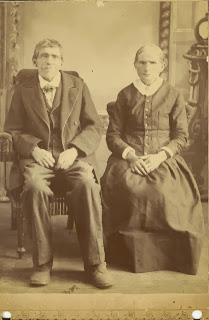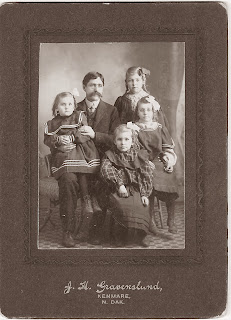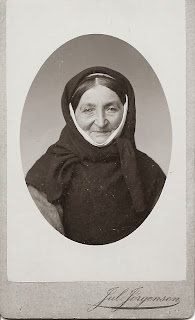Mother Carn Jacobson and children, from oldest to youngest:
Pete, Chris, Camilla, Caroline, James, Lewis and John
Until now all of my blogs have been about my Norwegian ancestors so the readers may think that my heritage is 100 percent Norske. Actually, I can claim 3/4 Norwegian, and 1/4 Dane, thanks to my maternal grandfather John Hanson Mestad, a Norwegian who married a Danish girl.
When I was a child and I was acting up or displaying extreme stubbornness my father would often say, "It must be the Dane in you!" I wasn't sure what that meant at the time except it probably wasn't good, but later I found out he was just trying to tease my Mom about her Danish roots.
Her mother, Caroline Jacobson, had immigrated to America from Denmark with her parents at the age of 10. She was the daughter of Andres (Andrew) Jacobsen and Karn Christine (Carn) Andersdatter who emigrated from the Aalborg area of Denmark and established a farm near Graettinger, Iowa in Walnut Township, Palo Alto County. Andrew came in 1882 and the following year his wife Carn and seven children joined him in Iowa.
Father Andrew and Mother Carn in Denmark
Possibly confirmation photos
Andrew Jacobson was 41 years old when he arrived in New York on March 28, 1882 on the ship Geiser which departed from Copenhagen. The next year his wife and family set sail on the SS Heimdal from Copenhagen and debarked in New York on May 4, 1883. Carn was born June 27, 1840 in Dronninglund, Denmark. She married Andrew Jacobsen in 1867. He was born February 24, 1841, the son of Jacob Anderson and Karen Marie Andersdatter of Sebbersund, Denmark
The years between the marriage of Andrew and Carn, the voyage to America and their reasons for emigrating from their homeland are lost in history as no other records have been found to date, but the fact is that the Jacobson's made their home in Iowa and stayed there the rest of their lives. Carn died in 1916 of cancer and Andrew in 1921 of kidney disease. They are buried at St. Paul's Lutheran cemetery in the country about two miles out of Graettinger.
The Jacobsen children, all born in Denmark, were Jacob Peter (Pete) 1868, Andrew Christian (Chris) 1870, Camilla 1872, Caroline 1873, Jens (James) 1874, Lars (Louis) 1878, and Johanne (John) 1879. They were listed on the Danish census in Vodskov, Aalborg, Denmark on April 14, 1883 just before leaving for America, with destination listed as Emmetsburg, Iowa the county seat of Palo Alto, County.
Andrew Jacobson house in Graettinger, Iowa
As fate would have it the Jacobson farm in Graettinger was just a few miles from Wallingford in Emmet County, Iowa where the Hanson family had settled. Hans Hanson and Britha Knudsdatter had both emigrated from Evanger, Voss, Norway in the 1850's and had married at Spring Prairie Church in Columbia County, Wisconsin in 1862. At the time Britha had a son Christopher, born in 1859 in Wisconsin, and in 1863 they had a son Knute born in Wisconsin. In 1865 my grandfather, John Hanson was born in Estherville, Emmet County, Iowa.
Tragedy ensued when the Hanson boys, Knute and John, were swimming one day in the Des Moines River with their older brother Chris. The current was swift and the two younger ones both had trouble keeping afloat. Chris only had time to save one of them which turned out to be John, and Knute was drowned. Another ironic twist of fate;--if Knute had been saved and my grandfather had drowned, I would not be here to tell the story!
I don't know the exact time this happened as I haven't found a death certificate for Knute, but the 1870 census shows the Hanson family in Peterson Township, Emmet County, as Hans Hanson 60, farmer; Betsy Hanson, 44, keeping house; Christopher Hanson 11; Knute Hanson 6; John Hanson, 5. In the 1880 census they are living in High Lake Township and the family consists of Hans 70, Betsty 55, Christopher 21, and John 15.
Hans and Britha Hanson, circa 1885
The only death record I have found for Hans Hanson was published in the Emmet County Republican, dated September 5, 1889: "Hans Hanson died at his home in High Lake, Tuesday morning, August 27, after a long and lingering illness. Funeral services were held Wednesday, August 28, from the church, Rev. Engh officiating." And in the Northern Vindicator of Emmet County, dated August 30, 1889: "Hans Hanson, residing in High Lake Township, died Tuesday morning. Mr. Hanson has been infirm for several years and his taking off was not a surprise." He would have been 78 years old.
I have found no death record for his wife Britha either. One problem in finding her is the name. At different times she was known as Britha, Brite, Betsy, and Bertha. In the 1895 State of Iowa census she was living as Bertha Hanson, 71, with her son Christopher and family in Estherville First Ward.
My grandfather John Hanson took Mestad as his last name when he was an adult. As my Mom explained it, her father thought there were just too many John Hanson's! He was an entrepreneur of sorts in Emmet County judging by newspaper articles I have found.
- Northern Vindicator, 10/4/1889: "Henry Hanson and John Mestad are the new boys who have purchased the Squier Restaurant. They are good boys and worthy successors to the old firm."
- 11/1/1889: "Mssr's. Hanson and Mestad have a new baker, a Mr. W. Nunn of Eagle Grove."
- 4/18/1890: "Hanson and Mestad are having their store repainted and kalsomined and a general cleaning up."
- Emmet County Republican ad, 5/15/1890: "HANSON AND MESTAD CITY RESTAURANT, A First Class Bakery. Fresh vegetables, fruits, confections, canned goods, etc."
- Vindicator, 10/3/1890: "Hanson and Mestad have sold out their restaurant to A. A. Lein and Aaron Peterson who will continue the business at the old stand."
- Republican, 12/25/1890: "A merry Christmas to all. Holiday trade is lively at this place. J. H. Mestad is working behind the counter at H. N. Osher's Store, John is a good salesman!"
Wedding photo, April 10, 1891, John and Carrie Mestad, right, and Pete and Caroline Jacobson, left.
The next year romance entered the picture, as John H. Mestad, 27, born Iowa, son of Hans Hanson and Brithe Knudsen; and Caroline Jacobson, 19, born Denmark, daughter of Andrew Jacobson and Christina Anderson, were married on April 10, 1891 in Graettinger, Iowa. Also married at the same time were Caroline's sister Camilla Jacobson, 20, born Denmark, to August O. Berg, 28, born Norway; and brother J. P. (Pete) Jacobson, 28, born Denmark, to Caroline Thomsen, 20, born Denmark.
My Mom always told me that her Danish grandparents were not pleased that both of their daughters chose to marry Norwegians. One must remember that back then the various ethnic groups of immigrants usually stayed with their own kind and their children were encouraged to do the same. The pioneer Scandinavian churches were Norwegian Lutheran, Danish Lutheran or Swedish Lutheran, each had their own pastors from the old country, and they wanted their children to remain "pure."
But there is no accounting for love, and marry they did, John Mestad and Caroline Jacobson. For the first ten years of their marriage they were content to stay in Iowa and started building their family. Four daughters were born to the Mestads, Alma Henrietta, 12 July, 1893; Cora Beatta, 17 March, 1895; Mayme Lucretia, 03 February, 1897; and lastly, Effie Jeanetta, my Mom, 01 August, 1899. John Mestad continued making the news during those years:
- Republican,11/1/1894: "John Mestad's name appears in the official ballots for High Lake Township for assessor on the democratic ticket. Mr. Mestad wants it understood that he is not a democrat and it was an oversight of his petitions that he got on that ticket. His name should have been in the independent column." (Note: He won.)
- Estherville Democrat, 5/17/1898: "John Mestad of the Lund hardware and implement firm, has purchased the widow Kries property at Wallingford and will add to the improvements as soon as possible. Mr. Mestad is now owner of a half block of the Wallingford soil. Mr. Lund has sold over one carload of binder twine and orders are still rushing in."
- Republican, 10/6/1898: J. H. Mestad entered a 40-1/2 pound pumpkin in the Pumpkin Contest and won a napkin ring. The first-prize pumpkin was 43-3/4 pounds.
- Democrat:, 3/30/1899: Mr. and Mrs. Adson of Terril visited their friends last Monday and made arrangements for the transfer of their real estate to Mr. J. H. Mestad and wife."
- Democrat, 5/3/1899: "John Mestad sold his farm last Friday at $25.00 per acre."
- Vindicator, 5/4/1899: "M. C. Stone and wife to J. H. Mestad, lots 1 and 2, block 2, Wallingford, $40.00."
- Democrat, 8/16/1899: "Mr. and Mrs. Mestad has added one more girl (Effie) to their household."
- Vindicator,9/22/1899: J. H. Mestad and wife to J. G. Remmers, nw quarter, sec 31,98,33. $3761.25."
- 9/27/1899: "J. H. Mestad is managing the T. J. Randolph hardware establishment and doing a good business."
The newspapers continue to tell the family story of the move to Dakota Territory in 1900. Evidently John Mestad's quest for government homestead land triggered the migration.
- Democrat, 4/4/1900: "John Mestad and Mr. Peterson left last week for their new home in South (sp) Dakota. Their many friends here are sorry to lose them from our midst. The best wishes of the DEMOCRAT go with them."
- Republican, 4/5/1900: "John Mestad accompanied by Carl Grinder left Tuesday for Ward County, North Dakota."
Troubles in their new home started almost immediately, as chronicled in the Estherville, Democrat, June 13, 1900:
- John Mestad writes from his new Dakota home that they have had no rain there this summer and that even the grass is dying. Evidently, there are worse places than Emmet County."
John Mestad and daughters after the death of Caroline
Alma, Cora, Mamie and Effie on Daddy's lap
Sometime that summer of 1900 John Mestad moved his wife and four daughters to the new homestead of 160 acres in Ward County, North Dakota (now Renville County) north of Kenmare. I don't know what type of housing was established there but I can imagine that it was quite primitive compared to their former home in Iowa. Tragedy visited once again, when in 1902 Caroline Mestad, pregnant with their fifth child, died of an appendicitis attack on the homestead leaving behind her husband and four daughters.
My mother, Effie Mestad, was just over two years old when she lost her mother. After she was old enough to understand her father told her the story, that when Caroline became ill he hitched up the horses and went as fast as he could to the town of Kenmare to find a doctor. The first doctor he found was drunk so he went to find another that would come with him, and by the time they reached Caroline it was too late to save her. It was determined that she died of a burst appendix.
I have never found a death certificate for my grandmother through the state of North Dakota, Ward County, or Renville County. At the Danish Lutheran Church in Kenmare there is this notation in their records: "Karoline Mistad, death April 25, 1902, burial April 29, 1902," but no record indicating that she was buried in the church cemetery. My assumption is that she was buried at the homestead which was not recorded, and that my grandfather asked the Danish Lutheran pastor to officiate. Another one of those SUI (Still Under Investigation) mysteries that may never be solved!
I am in possession of John Hanson's autograph book from the old days in Iowa with words and verses of inspiration written by many friends and relatives, some in the Norwegian language. One that is particularly haunting and prophetic was penned by his wife Caroline on May 1, 1892, with these words: "Forget me when I die; The violets above my rest will blossom just as blue; Nor miss my tears: ev'n Nature's self forgets; but while I live, be true. Your wife, Mrs. Carrie Mestad."
I can imagine the grief of the Jacobson family back in Iowa who had suffered a double loss, first that John Mestad had taken their daughter and grandchildren away to wild and woolly North Dakota and secondly, she had died there. To triple the tragedy, their only other daughter, Camilla, married to Norwegian August Berg, had followed John and Caroline out to Kenmare and Camilla died young also. A Register of Deeds Office certificate shows that August O. Berg purchased 159 and 95 hundredths acres in Ward County on November 16, 1903 for $199. On the 1910 census it shows August Berg, 46, widowed, Alma, 16; Katie, 14 and Arthur 12. Jacobson sons Peter, Louie, James and John all moved to Minot area for a time and acquired land but returned to Iowa after a few years.
The John Mestad home in Kenmare, North Dakota
John Mestad tried to keep the home and hearth going as a single father but times were too hard and he finally determined that he couldn't keep the homestead. He moved his children into the town of Kenmare where he used his old salesman skills working at P. M. Coles Grocery, and Badmers and Dresser's Clothing respectively. In 1907 he married his housekeeper, Olga Estabrook. She had been married previously but her first husband had reportedly ran off and taken their only daughter with him. Olga did not see her daughter Gladys again until she was grown up.
John and Olga Mestad, circa 1930's
After the marriage my grandfather would go to work leaving his new wife in charge of his daughters. What he didn't know is that Olga, or Nana as they were told to call her, had a very bad temper and she was mean to the girls when their father was away. She often threatened them with bodily harm if they told him. She chased the older girls around with brooms and screamed at them, although she treated my Mom a little better since she was the baby and the same age as her own daughter. In 1923, after the Mestad girls were grown and had left home, John and Olga moved to Minot where John sold Raleigh products and they established a small grocery and candy store in their home with living quarters in the back. My grandfather died January 1, 1945 when I was 5, and since he lived in North Dakota and we lived in Minnesota I saw him only a few times. I knew of him from his daughters, who adored their Papa, as a kind, gentle, and godly man who was loved by all.
Growing up in North Dakota, my mother and her sisters had very little contact with their Danish grandparents and relatives, especially after the death of Camilla and the return of the Jacobson brothers to Iowa. She longed for her mother but had no memory of her, so all she knew were the tidbits she gathered from her father and older sisters.
The girls were not allowed to talk about their mother around Olga and the "wicked stepmother" even cut the heads out of a large portrait of Caroline and John together. Luckily the older girls saved the heads and I still have them today, passed down to me by my aunt Cora.
John Mestad and daughters circa 1930 during trip back to Iowa.
From left, Cora, Alma, Mayme, and Effie on Daddy's lap
In later years my grandfather and his daughters made a trip back to Iowa to visit the Jacobson uncles and cousins, and I can remember as a little girl traveling to Iowa once or twice to visit Chris (Sena) Jacobson, their only son Malta (Laura) and daughters Donna and Karen, just a few years older than me.
In the early 1990's after I had started my quest for family history, I went to Estherville and Wallingford to meet my Mom's cousins, Mildred (Henry) Sunde, daughter of John; and Vernie (Mildred) Jacobson, son of James.
At that time I saw for the first time a picture of my Mom's grandparents, Andrew and Carn, and a photo of her great-grandmother, Andrew's mother Karen Marie. I was stunned by how much my mom Effie resembled her! Vernie told me that there were a lot of family photos from Denmark but many of them had no identification. At that time I also visited the country church and cemetery where the Jacobson's were buried.
Andrew Jacobson's mother Karen Marie Andersdatter; Effie Mestad Enger , circa 1950
St. Paul's Lutheran Church, Graettinger, Iowa 2009, formerly Old Walnut Church
Gravestones of Andrew and Carn Jacobson across from St. Paul's Church
A couple of years later Vernie's grandson, Mike Torreson of Wallingford, stopped to see me in Sequim, Washington when he was out looking for old railroad memorabilia and in the summer of 2009 I went back to Wallingford and Graettinger on a roots-finding mission. This time Mike introduced me to his Mom Lois (Ralph) Torreson, daughter of Vernie. Her parents are both gone now and she has the old family photos which she kindly let me scan into my computer. What a treasure! On that trip I also met Harold Sunde, son of Mildred and Henry who both had passed away since my last visit. I was so happy to make these connections with my Danish family tree, and I hope to see them again on future travels.The writer in 1991 with Jacobson cousins Vernie,
son of James, and Mildred (Sunde), daughter of John.




















